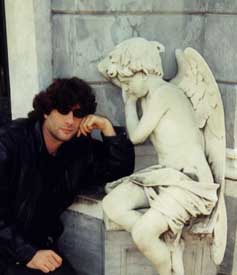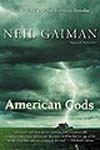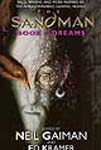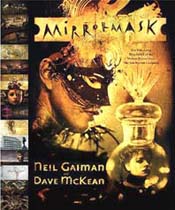Sandman
Sandman Gets in Your Brain
 There is a curious typographical error in John Clute and John Grant’s vast and splendid Encyclopedia of Fantasy. Neil Gaiman’s entry correctly gives the year of his birth as 1960, but after the dash, the space that should be left blank for a living author gives ‘Frankenstein Movies’ as the time of his death! Gaiman nods when I mention this oddity – he is well aware of the mistake and, I think, rather charmed by it. ‘What a terrible way to die,’ he says dryly. ‘That’s got to be the worst way to go …’
There is a curious typographical error in John Clute and John Grant’s vast and splendid Encyclopedia of Fantasy. Neil Gaiman’s entry correctly gives the year of his birth as 1960, but after the dash, the space that should be left blank for a living author gives ‘Frankenstein Movies’ as the time of his death! Gaiman nods when I mention this oddity – he is well aware of the mistake and, I think, rather charmed by it. ‘What a terrible way to die,’ he says dryly. ‘That’s got to be the worst way to go …’
This English author made his name scripting American comic books such as Black Orchid (1989), The Books of Magic (1993) and Death: The High Cost of Living (1993), but he has also worked in a wide variety of other forms. Good Omens (1990), a humorous fantasy written in collaboration with Terry Pratchett, became a bestseller, and Neverwhere (1996) was produced as a bbc television series. Gaiman has now produced American Gods (2001), an epic story about the struggle of mythological archetypes to survive in the rational modern world.
The novel reinterprets some of the themes of Sandman (1990-96), his best-known work. This long-running and ambitious comic-book series charted the final years of Morpheus, the son of Sleep in Classical mythology. Also known as Dream, this brooding character is one of the Endless, a family of seven archetypal figures including Destiny, Desire, Delirium, Destruction, Despair and Death. Norman Mailer called Sandman, ‘A comic strip for intellectuals and I say it’s about time.’ One episode involving William Shakespeare, ‘A Midsummer Night’s Dream’, broke new ground by winning the World Fantasy Award for Best Short Story in 1991.
Gaiman makes no apology for his explorations of various narrative forms: ‘I’ve got pretty pissed off over the years with people who’ve said to me, like when Stardust [1998] and Neverwhere came out, ‘How does it feel to have finally done something important?’ I’d say, ‘Actually, my important thing was Sandman. Neverwhere is an adventure story, Stardust is a fairy-tale, Sandman is two thousand pages, ten volumes, and that’s my important thing.’ Now I’ve done American Gods, which I think can go head to head with Sandman. I’m very happy for the first time with a prose book.’
 The novel tells the story of Shadow, a troubled ex-convict who has lost his wife and best friend under suspicious circumstances just days before his release from prison. Cut adrift in the Midwest, he is employed by Mr Wednesday, an itinerant con artist with supernatural powers who claims to be the king of America. The mismatched pair travel across the United States to an apocalyptic battle involving the old, abandoned gods who have no more worshippers and are reduced to a twilight existence.
The novel tells the story of Shadow, a troubled ex-convict who has lost his wife and best friend under suspicious circumstances just days before his release from prison. Cut adrift in the Midwest, he is employed by Mr Wednesday, an itinerant con artist with supernatural powers who claims to be the king of America. The mismatched pair travel across the United States to an apocalyptic battle involving the old, abandoned gods who have no more worshippers and are reduced to a twilight existence.
American Gods confronts realistic ordinary characters with the marvellous in surreal juxtapositions that make them interact with archetypes from the collective unconscious, with results that can be hilarious, terrifying, tragic or redemptive. These devices are used throughout Gaiman’s work. All that he does is carefully planned and structured in advance, even the massive Sandman series. ‘I knew the shape. It was kind of the same with American Gods, although I rejoiced in the fact that I was not writing serial fiction. I loved being able to get to the end, and then figure out what it was that I’d done and make sure that, on the second draft, I’d done it the whole way through.’
The novel is a compelling vision of the persistence of mythology and dreams, invoking forgotten parts of the history and landscape of America. Gaiman does not see it as an attempt to storm the impregnable fortress of the Great American Novel, but concedes that his move from the uk to Minnesota might have driven him to write a great American immigrant novel.
The core theme of American Gods is that North America is a continent made up of immigrant peoples who arrived carrying the cultural baggage of their legends. Gaiman’s research into the past chronicles and prehistory of the usa has not pleased everyone. His eighteen-year-old son returned from school one day saying that a teacher had called Gaiman a liar because of his observations on slavery. Everyone who had come to America, she told his son, had come for freedom. Gaiman asked his son what he thought of this attitude and was pleased to be told, ‘I think she’s an idiot.’
The writing of American Gods proved to be a lonely creative experience: ‘I’m a very collaborative sort of person and I like being able to enjoy stuff that I’ve done, which I’m not very good at doing when it comes to American Gods. I look at it, I can proof-read it, I can worry about whether that comma was in the right place or not, but I can’t enjoy it, whereas I can enjoy Good Omens because Terry wrote half of it. I could enjoy Sandman because different people have drawn it.’
Although he had written several non-fiction books in the mid-eighties, Violent Cases (1987), illustrated by cutting-edge artist Dave McKean, announced him as an exciting and original voice in British fantasy writing. This graphic novel is an powerful evocation of childhood memories and fantasies, in which both stage and occult magicians, as well as Chicago gangsters, coexist in an English small-town setting.
‘Violent Cases was not my first published work,’ he points out, ‘there were short stories before that. I began by writing it as a short story, but that was because I was writing it for Dave McKean and I didn’t know how else to do it. Dave has a better visual sense and a better storytelling sense than I do. This is not me putting myself down: Dave has a better visual and storytelling sense than anyone I’ve ever met. I really didn’t want to start it, ‘Page 1, Panel 1, this is what we’re looking at,’ because this was Dave McKean and he knows what he’s doing better than I do. It seemed much smarter to do a first-person narrative, and then give him the text and say, ‘Here you go, do what you want with this.”
 Gaiman sees similarities between writing for comics and scripting for the stage, especially since the finished product can often astonish him and throw new light on his words. ‘Oddly enough, the nearest to it is writing radio plays, which may seem strange because one medium is full of pictures and the other has no pictures at all. I feel the listener is providing the image track with radio plays.’
Gaiman sees similarities between writing for comics and scripting for the stage, especially since the finished product can often astonish him and throw new light on his words. ‘Oddly enough, the nearest to it is writing radio plays, which may seem strange because one medium is full of pictures and the other has no pictures at all. I feel the listener is providing the image track with radio plays.’
Signal to Noise (1992), originally another graphic collaboration with Dave McKean, was broadcast on Radio 3 with Warren Mitchell playing the dying film producer working on a treatment for an apocalyptic movie that he is fully aware will never go before the cameras. ‘It was lovely doing it as a radio play. I’ve done several short stories over the years for the Sci-Fi Channel that they’ve put up on their website as audio plays. I can see why it was Angela Carter’s favourite medium because you can do so much with it.’
Gaiman’s fascination with different forms is tempered with his sardonic view of the pitfalls in swapping one medium for another. ‘I like writing for comics. I’ve always thought it was interesting that – in theory – it always seemed like novelists should write great comics and, for that matter, film writers should be able to write great comics. In practice, as many film writers and novelists write great comics as novelists write great film scripts or film writers write great novels, which is to say a few do, but most don’t.’
Nevertheless, he continues to test the limits of his creativity. ‘I suppose a lot of that is because I think of myself as a storyteller and I try and exploit whatever medium I’m into. I never thought of myself as a comics writer. I thought of myself as a storyteller using a medium I happened to delight in. It’s an embarrassing confession to make now I’m a New York Times bestselling author – which in America is a terribly important thing – but I don’t consider myself a novelist and I don’t really consider myself a bestseller. I think of myself as a storyteller who’s written a novel which did ok.
‘It’s very frustrating to most of the people I know that I refuse to go and sit in a big box and stay there, but I would much rather wander the house seeing what else I can do. I also think the fans very often find it frustrating that, once I get good at something, I tend to go off and try and do something which I don’t do as well to figure out how to do it. The odds are very good that, having done a novel that I’m pleased with, I’ll probably spend several years mucking around in Hollywood trying to get a film script that I’m actually pleased with. I’m not as good at scripts as I am at the other stuff and I don’t see why I shouldn’t learn how to do that too.’
He still tries to keep up with the work of the other comics writers whom he respects, many of whom are Scottish, like Glaswegian Grant Morrison. ‘I think that Grant is the best of all the Scottish writers,’ he says before remembering many of the other Scots who have worked for Britain’s own science fiction comic 2000 AD, the home of Judge Dredd.
 For The Sandman: Book of Dreams (HarperPrism, 1996) Neil Gaiman invited leading fantasy writers to write stories based on his Sandman world.
For The Sandman: Book of Dreams (HarperPrism, 1996) Neil Gaiman invited leading fantasy writers to write stories based on his Sandman world.
‘Actually, that’s very unfair because you also have Alan Grant, who’s brilliant, you have Pat Mills, who is sporadically brilliant, and you have John Wagner, who may have been born in America but is also Scottish. You have an incredibly strong bunch of Scottish writers. Grant Morrison is my favourite and Alan Grant is probably my favourite of the mainstream bunch.’
Morrison has written many witty and twisted spins on the American comic-book, including Animal Man, Doom Patrol and The Invisibles. ‘Grant Morrison is a lunatic, and I mean that in a caring, loving, nicest-possible way. I could not do that stuff, I couldn’t go there. What I do tends to be very controlled, very thought out. Even when I’m doing the equivalent of heading out into the dark on a tightrope, I will feel my way out a step at a time. Grant seems perfectly happy to dash off into the dark on a tightrope, and jump up and down a lot to see what’s going to happen.’
The overly commercial side of comic collecting is not something that Gaiman is comfortable with, even though his own work is highly prized. ‘The first hardback edition of Season of Mists (1992) – as long as it’s not the Book Club edition, which is almost identical – goes for ridiculous prices, $150, $200 dollars. I don’t actually like that very much. I’m essentially quite pleased that prices have been coming down because lots of people have been selling their collections – and they’re then able to buy the trade paperbacks with the proceeds, plus something else they want. I like that because I never felt that I was dealing in collectables, I was trying to create stories.
‘The whole collectable thing actually frustrates me. For example, my first short story collection was a small press book that I did through Dreamhaven Books in Minneapolis called Angels and Visitations (1993). It went through five printings – it was only ever meant to be a small-press book. And, finally, at 25,000 copies, I said, ‘We are putting this out of print’, put most of the stories I like into a new collection called Smoke and Mirrors (1998) and left it there.’
‘What I wasn’t expecting was that most copies of Angels and Visitations will now set you back in excess of $100. We’re not even talking first printing here, we’re just talking a copy – a first printing could be anything up to about $150. Now that irritates me enough that I’ve basically said to Dreamhaven, ‘ok, later next year we’re going to go back to press and do another 5000, just because there’s probably a thousand people out there who desperately want a copy. Once they can all get a copy and once there are a few more out there, the price will go back to something more sensible and we’ll sell them for $25 – 30 each. Then the overall price can come down $30 or $40 each and everybody will be happy.’
Despite his feelings, Gaiman is not immune to the bug. ‘I’m only a book collector myself in a very small way and, even then, I’m not a first edition collector. The problem is, some of the books I want, by authors like James Branch Cabell, only exist in ‘collectable’ form. Some of his books only came out in signed editions or in tiny print runs in 1905 and you have to have them. I have a wonderfully impressive James Branch Cabell collection and I’m very happy to have it.
‘I was rather disappointed when I wrote a letter to an author named Nelson Bond, who, oddly enough, I remembered from my childhood. He wrote the classic Mr Mergenthwirker’s Lobblies and Other Fantastic Tales (1946). Bond was also Cabell’s literary executor and, in a small way, a Cabell dealer. I wrote to him and he sent me a list. I went through it, gradually realizing that I actually did have absolutely everything on this two-page list!
‘Beyond that, I have a signed G.K. Chesterton book. When I got hold of a second one, I sent it to Gene Wolfe [the distinguished American writer of fantasy and science fiction] because I didn’t think that anybody needed two signed Chestertons. I have two signed, limited, Lord Dunsany books: one because I saw it and fell in love; and one because it seemed really, really sad in the little secondhand bookshop where it was being kept prisoner, and I thought I would liberate it and take it home where at least it would know that it was loved.’
 Gaiman’s enthusiasm for the great Irish fantasist bubbles over. ‘They did a couple of beautiful editions of The King of Elfland’s Daughter and Don Rodriguez, big books illustrated by Sime, and signed by Sime and Dunsany – gorgeous books! You know, you can tell he’s writing with a quill pen as well, which is great. The man’s signature is this huge thing – Dunsany! That’s all it says – that’s style. Mine is sort of gurgle-gurgle. If I had a quill pen, it would say Dunsany too!’
Gaiman’s enthusiasm for the great Irish fantasist bubbles over. ‘They did a couple of beautiful editions of The King of Elfland’s Daughter and Don Rodriguez, big books illustrated by Sime, and signed by Sime and Dunsany – gorgeous books! You know, you can tell he’s writing with a quill pen as well, which is great. The man’s signature is this huge thing – Dunsany! That’s all it says – that’s style. Mine is sort of gurgle-gurgle. If I had a quill pen, it would say Dunsany too!’
Copyright Andrew Wilson 2005.

Comments